Top Rankings
Manchester School District ranks among the top 20% of public school district in New Hampshire for:
Category
Attribute
Diversity
Most diverse schools (Top 1%)
Community Size
Largest student body (number of students) (Top 1%)
For the 2025 school year, there are 10 public preschools serving 4,028 students in Manchester School District. This district's average pre testing ranking is 2/10, which is in the bottom 50% of public pre schools in New Hampshire.
Public Preschools in Manchester School District have an average math proficiency score of 26% (versus the New Hampshire public pre school average of 44%), and reading proficiency score of 31% (versus the 47% statewide average).
Minority enrollment is 47% of the student body (majority Hispanic), which is more than the New Hampshire public preschool average of 16% (majority Hispanic).
Overview
This School District
This State (NH)
# Schools
21 Schools
149 Schools
# Students
11,936 Students
39,813 Students
# Teachers
1,036 Teachers
3,470 Teachers
Student : Teacher Ratio
12:1
12:1
District Rank
Manchester School District, which is ranked within the bottom 50% of all 189 school districts in New Hampshire (based off of combined math and reading proficiency testing data) for the 2021-2022 school year.
The school district's graduation rate of 72% has decreased from 77% over five school years.
Overall District Rank
#183 out of 189 school districts
(Bottom 50%)
(Bottom 50%)
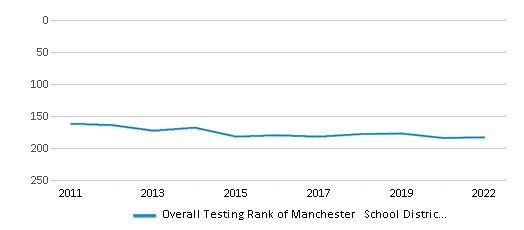
Math Test Scores (% Proficient)
16%
40%
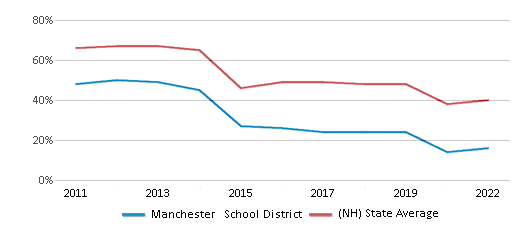
Reading/Language Arts Test Scores (% Proficient)
28%
51%
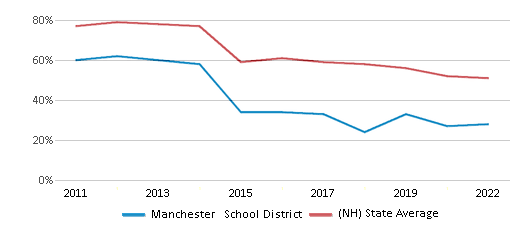
Science Test Scores (% Proficient)
16%
36%
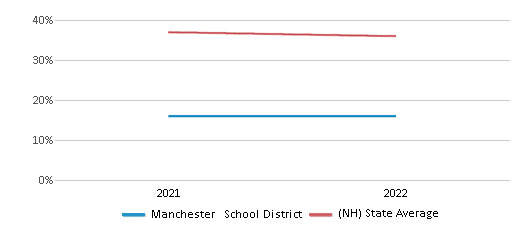
Graduation Rate
72%
88%
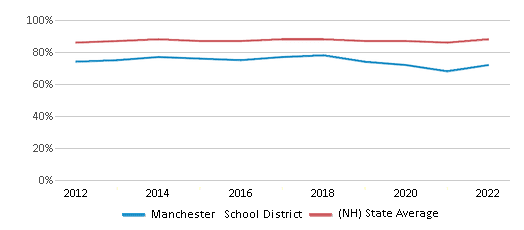
Students by Ethnicity:
Diversity Score
0.68
0.29
# American Indian Students
19 Students
71 Students
% American Indian Students
n/a
n/a
# Asian Students
453 Students
952 Students
% Asian Students
4%
3%
# Hispanic Students
3,136 Students
2,514 Students
% Hispanic Students
26%
6%
# Black Students
1,283 Students
807 Students
% Black Students
11%
2%
# White Students
5,810 Students
33,448 Students
% White Students
49%
84%
# Hawaiian Students
10 Students
29 Students
% Hawaiian Students
n/a
n/a
# Two or more races Students
1,225 Students
1,992 Students
% of Two or more races Students
10%
5%
Students by Grade:
# Students in PK Grade:
380
4,442
# Students in K Grade:
839
6,330
# Students in 1st Grade:
935
6,046
# Students in 2nd Grade:
925
6,232
# Students in 3rd Grade:
874
5,421
# Students in 4th Grade:
942
5,076
# Students in 5th Grade:
886
3,284
# Students in 6th Grade:
867
1,218
# Students in 7th Grade:
888
887
# Students in 8th Grade:
843
877
# Students in 9th Grade:
1,111
-
# Students in 10th Grade:
880
-
# Students in 11th Grade:
887
-
# Students in 12th Grade:
679
-
# Ungraded Students:
-
-
District Revenue and Spending
The revenue/student of $17,700 in this school district is less than the state median of $22,075. The school district revenue/student has stayed relatively flat over four school years.
The school district's spending/student of $15,737 is less than the state median of $21,293. The school district spending/student has stayed relatively flat over four school years.
Total Revenue
$211 MM
$3,646 MM
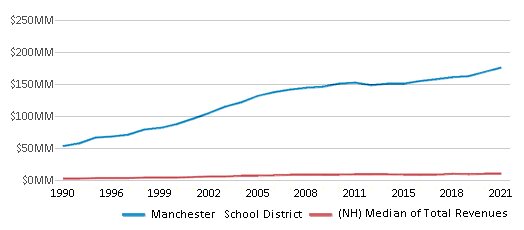
Spending
$188 MM
$3,517 MM

Revenue / Student
$17,700
$22,075
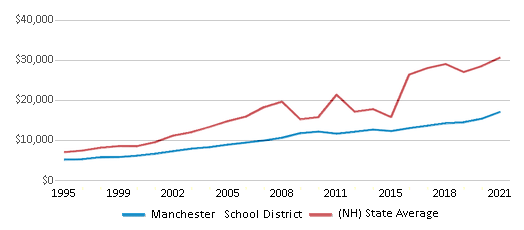
Spending / Student
$15,737
$21,293
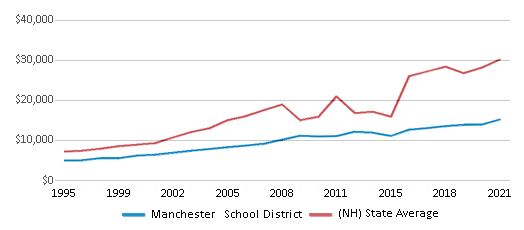
Best Manchester School District Public Preschools (2025)
School
(Math and Reading Proficiency)
(Math and Reading Proficiency)
Location
Grades
Students
Rank: #11.
Webster School
(Math: 35-39% | Reading: 40-44%)
Rank:
Rank:
4/
Bottom 50%10
2519 Elm St.
Manchester, NH 03104
(603) 624-6344
Manchester, NH 03104
(603) 624-6344
Grades: PK-5
| 374 students
Rank: #22.
Green Acres School
(Math: 31% | Reading: 43%)
Rank:
Rank:
3/
Bottom 50%10
100 Jack Lovering Drive
Manchester, NH 03109
(603) 624-6330
Manchester, NH 03109
(603) 624-6330
Grades: PK-5
| 433 students
Rank: #33.
Highland-goffes Falls School
(Math: 30-34% | Reading: 35-39%)
Rank:
Rank:
3/
Bottom 50%10
2021 Goffs Falls Rd.
Manchester, NH 03103
(603) 624-6334
Manchester, NH 03103
(603) 624-6334
Grades: PK-4
| 337 students
Rank: #44.
Smyth Road School
(Math: 25-29% | Reading: 40-44%)
Rank:
Rank:
3/
Bottom 50%10
245 Bruce Rd.
Manchester, NH 03104
(603) 624-6340
Manchester, NH 03104
(603) 624-6340
Grades: PK-5
| 390 students
Rank: #55.
Jewett School
(Math: 30-34% | Reading: 20-24%)
Rank:
Rank:
2/
Bottom 50%10
130 S. Jewett St.
Manchester, NH 03103
(603) 624-6336
Manchester, NH 03103
(603) 624-6336
Grades: PK-4
| 453 students
Rank: #66.
Weston Elementary School
(Math: 25-29% | Reading: 25-29%)
Rank:
Rank:
2/
Bottom 50%10
7 Michigan Avenue
Manchester, NH 03104
(603) 624-6347
Manchester, NH 03104
(603) 624-6347
Grades: PK-5
| 507 students
Rank: #77.
Bakersville School
(Math: 20-24% | Reading: 30-34%)
Rank:
Rank:
2/
Bottom 50%10
20 Elm St.
Manchester, NH 03101
(603) 624-6312
Manchester, NH 03101
(603) 624-6312
Grades: PK-4
| 344 students
Rank: #88.
Mcdonough School
(Math: 17% | Reading: 23%)
Rank:
Rank:
1/
Bottom 50%10
550 Lowell St.
Manchester, NH 03104
(603) 624-6373
Manchester, NH 03104
(603) 624-6373
Grades: PK-5
| 457 students
Rank: #99.
Parker-varney School
(Math: 15-19% | Reading: 15-19%)
Rank:
Rank:
1/
Bottom 50%10
223 James Pollack Dr.
Manchester, NH 03102
(603) 624-6338
Manchester, NH 03102
(603) 624-6338
Grades: PK-4
| 394 students
Rank: #1010.
Gossler Park School
(Math: 10-14% | Reading: 10-14%)
Rank:
Rank:
1/
Bottom 50%10
145 Parkside Ave
Manchester, NH 03102
(603) 624-6327
Manchester, NH 03102
(603) 624-6327
Grades: PK-4
| 339 students
Recent Articles

Year-Round Or Traditional Schedule?
Which is more appropriate for your child? A year-round attendance schedule or traditional schedule? We look at the pros and cons.

Why You Should Encourage Your Child to Join a Sports Team
Participating in team sports has a great many benefits for children, there is no doubt. In this article you will learn what those benefits are.

White Students are Now the Minority in U.S. Public Schools
Increasing birth rates among immigrant families from Asia and Central and South America, combined with lower birth rates among white families, means that for the first time in history, public school students in the United States are majority-minority. This shift in demographics poses difficulties for schools as they work to accommodate children of varying language abilities and socio-economic backgrounds.





